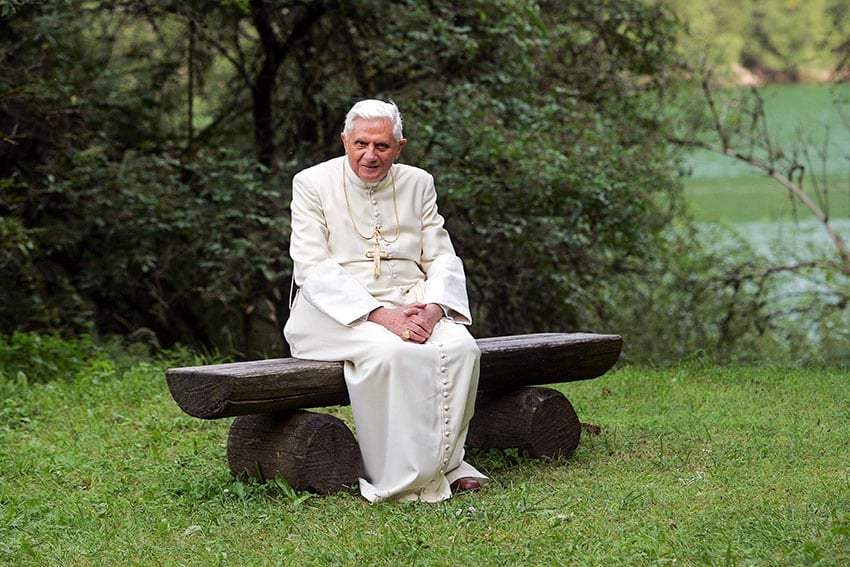
By Russell Shaw
After spending more than 20 years as prefect of the Vatican’s Congregation for the Doctrine of the Faith during the papacy of Pope St John Paul II, then-Cardinal Joseph Ratzinger succeeded John Paul as pope following the Polish pontiff’s death in 2005. Cardinal Ratzinger became the 16th pope to take the name Benedict. He reigned as the successor of St Peter until his resignation on 28 February 2013.
While the current generation of Catholics will know Pope Benedict through his legacy as pope, it’s unlikely that he would have been entrusted with such a lofty position if it wasn’t for his immense and important work as a priest-theologian — starting, most notably, with his work for the Second Vatican Council.
Ratzinger’s influences
Pope Benedict XVI’s long, close relationship to the Second Vatican Council had two distinct but by no means unrelated aspects. Partly, it reflected his role as a young theologian at Vatican II. And partly, it arose from his implementation — and especially from his interpretation — of the council as a landmark in Church history.
In both aspects, Benedict’s decadeslong identification with the ecumenical council is a central part of his legacy.
Held in four sessions from 1962 to 1965, Vatican Council II was the most important event in the life of the Church in the 20th century — and some would say the most important since the 16th century Council of Trent, a reforming council that placed its stamp on the Church for 400 years.
Christopher Ruddy, an associate professor of theology at the Catholic University of America who has written often on Benedict, considers “commitment to Church renewal” the cause that especially links him and Vatican II. Central to it, Ruddy says, are two complementary driving forces: “‘aggiornamento’ — an updating of the Church in response to the signs of the times — and ‘ressourcement’ — a return to the sources of the Church’s traditions.”
To fully understand Benedict the theologian, it’s necessary to grasp the role played in shaping his theological stance by St Augustine, who with St Thomas Aquinas is one of the two most influential thinkers in Church history. Starting in 1954 with his first book, on Augustine’s theology of the Church, it can be seen a half-century later in his first encyclical as pope, Deus Caritas Est (“God Is Love”), which reflects what one writer calls Augustine’s “absorption in the idea of love.”
To fully understand Benedict the theologian, it’s necessary to grasp the role played in shaping his theological stance by … St Augustine’s “absorption in the idea of love.”
“Being a Christian,” Benedict writes there, “is not the result of an ethical choice or a lofty idea, but the encounter with an event, a person” — Jesus Christ. That realisation, central to his theology, is basic to the “passionate desire to know the love of Christ,” which Ruddy and others find in his writing.
Vatican II
Father Joseph Ratzinger was 35 when Cardinal Joseph Frings of Cologne, Germany, chose him to be his peritus (or theological adviser) at the ecumenical council that Pope St John XXIII, surprising many, had convoked in early 1959, shortly after his election.
Cardinal Frings, president of the German bishops’ conference, was a powerful figure at the council as one of its cardinal-presidents, and his youthful theologian was propelled into a heady role as one of the theological progressives working to shape the assembly. This was a group that included such luminaries of that day as Yves Congar OP, Edward Schillebeeckx OP, Henri de Lubac SJ, Hans Kung and — most influential of all during Vatican II — Karl Rahner SJ.
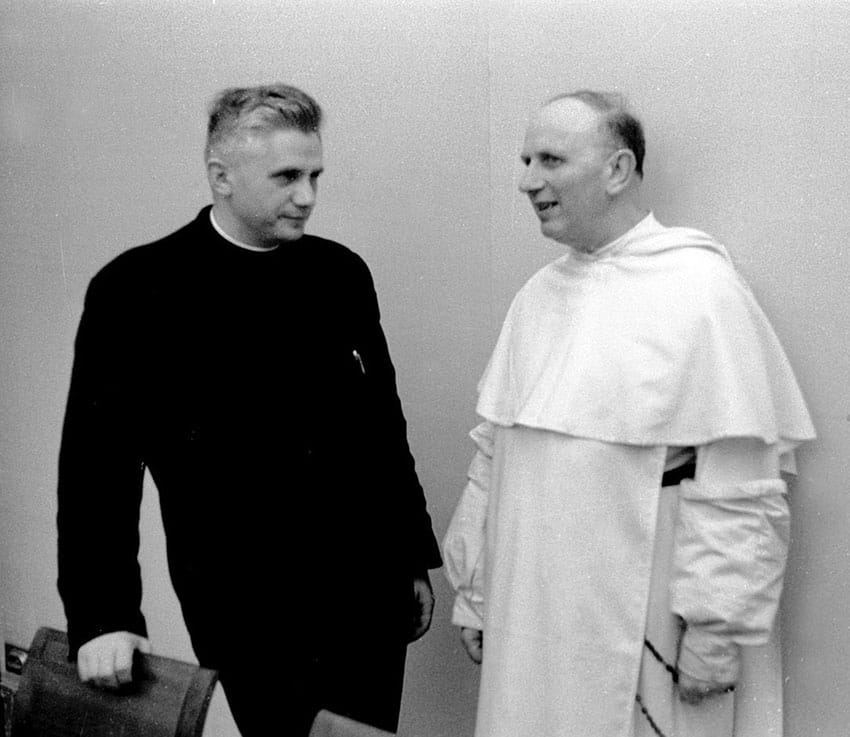
Although the council’s documents were the work of many hands, Father Ratzinger had an important part in writing the Dogmatic Constitution on the Church, Lumen Gentium (“The Light of Humanity” — that is, Christ). This was of particular significance in that Lumen Gentium, Vatican II’s theological centrepiece, provided the conceptual basis for other council documents on subjects such as ecumenism, the role of bishops and the role of the laity.
Father Ratzinger’s special contribution was working out the theological underpinnings of “collegiality” — the idea that bishops in communion with the pope make up a single body or “college” responsible for governing and teaching the universal Church. He also drafted the theological section of Ad Gentes, the Decree in Missionary Activity, which declares the Church to be “by its very nature missionary.”
Although he was a team player with his theological colleagues while the council was in progress, his position appears to have shifted as it neared its end. In his Vatican II history, The Rhine Flows Into the Tiber, Father Ralph Wiltgen SVD, writes that Father Ratzinger gave “almost unquestioning support” to Karl Rahner’s views while Vatican II was underway, but “as it was drawing to a close, he admitted that he disagreed on various points, and said he would begin to assert himself more after the council was over.”
And so he did.
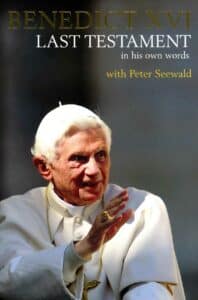
Finding his voice
Between sessions of the council, he had written articles for a German newspaper discussing developments there. Collected and published in book form under the title Theological Highlights of Vatican II, this material remains an exceptionally clear and informative account from a genuine insider.
In the introduction to the book’s English edition, published in 1966, he touched on a serious problem he already saw taking shape. “We would misunderstand the council’s teaching,” he wrote, “were we to take it as a sudden switchover, a sudden shift from ‘conservatism’ to ‘progressivism.’” Not only that, he added, using the words “conservative” and “progressive” with their political connotations is itself a mistake when speaking of the Church’s renewal. Instead, he insisted, “the measure of the renewal is Christ [and] the objective is precisely that Christ may become understood.”
In 1968, he published one of his best known books, Introduction to Christianity, which Catholic author Robert Royal calls “a brilliant apologetic.” In its preface, Father Ratzinger expresses growing concern about the state of faith, “enveloped today in a greater fog of uncertainty than at almost any earlier period in history.” His aim, therefore, was to help relieve that condition by explaining Christian faith “without changing it into the small coin of empty talk painfully laboring to hide a complete spiritual vacuum.”
Another stage in the same project came four years later. Progressive theologians for some time had been accustomed to expound their views in a journal called Concilium. In 1972, Father Ratzinger joined Father de Lubac and Father Hans Urs von Balthasar in founding a new journal, Communio, as a forum for those interested in theologising in continuity with the Catholic tradition.
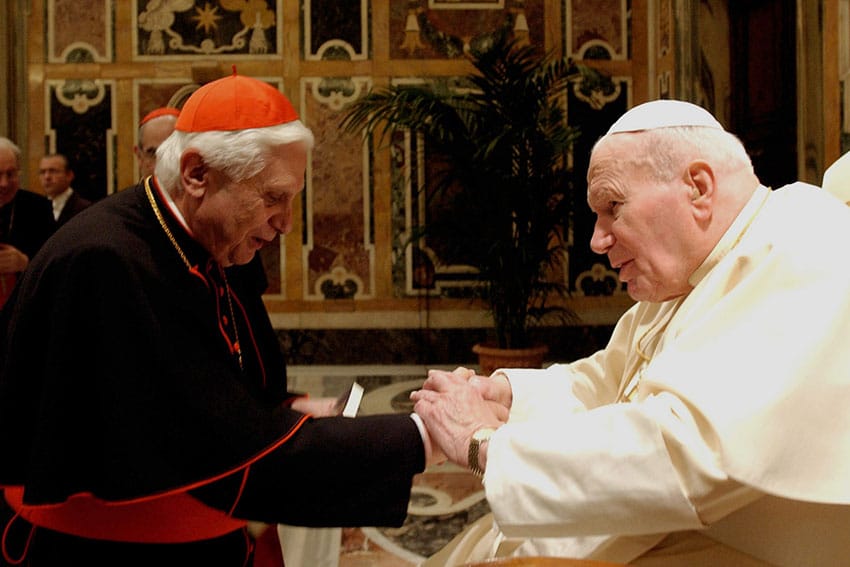
Doctrine of the Church
Upon accepting Pope St John Paul II’s 1981 invitation to become prefect of the Congregation for the Doctrine of the Faith, the then-Cardinal Ratzinger became one of the pope’s closest collaborators. As head of the CDF, he was involved in the preparation of official documents on controversial issues such as homosexuality and the ordination of women as priests.
Two CDF documents of the Ratzinger years critiqued liberation theology, then identified especially with some Latin American theologians and thought to provide a theological basis for revolution in society and upheaval in the Church. The first document, appearing in 1984, criticised Marxist elements in liberationist thinking, including endorsement of class conflict and this-worldly utopianism. The second, two years later, stressed positive aspects. “Liberation is first and foremost liberation from sin,” Cardinal Ratzinger declared.
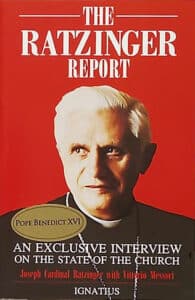
The year 1985 brought publication of The Ratzinger Report, a book-length interview in which the cardinal discussed many of the aberrations plaguing the Church. While many readers appreciated his clarity and candor, Church liberals generally saw it as one more black mark against him.
From 1986 to 1992, he headed the commission responsible for writing the new Catechism of the Catholic Church — the first general catechism in 400 years. Some Church liberals, wanting doctrine to remain in flux, opposed the project. But the new catechism was successfully completed and published in 1992, and is now considered one of the enduring achievements of the pontificate of Pope St John Paul II.
A successor of St Peter
Following Pope John Paul’s death in 2005, Cardinal Ratzinger preached the homily at the Mass attended by cardinals preparing to enter the conclave at which they would elect John Paul’s successor. It was then that he spoke of the “dictatorship of relativism” that he saw infecting not only secular society but the Church. The cardinals responded by choosing him as pope.
The hostility and suspicion toward him that his opponents had fomented for years carried over into the new pontificate, with some media predicting the ‘Panzerkardinal’ would be a reactionary, repressive pope. The encyclical Deus Caritas Est, therefore, came as a surprise to many, emphasising as it did “the love that God lavishes on us and that we, in turn, must share with others.” Ruddy calls it “an attempt to show to a skeptical modernity that God is not the enemy of human flourishing, but its very possibility and fulfillment.”
Among other things, the encyclical cautioned against a monopoly of works of charity by the all-encompassing modern state. Pope Benedict wrote:
“There will always be suffering that cries out for consolation and help. There will always be loneliness. There will always be situations of material need where help in the form of concrete love of neighbor is indispensable. The state that would provide everything, absorbing everything into itself, would ultimately become a mere bureaucracy incapable of guaranteeing what the suffering person — every person — needs: namely, loving personal concern” (No. 28).
As for the charitable activity of the Church, Benedict insisted it be “independent of parties and ideologies.” He added, “It is not a means of changing the world ideologically, and it is not at the service of worldly stratagems, but it is a way of making present here and now the love that man always needs.”
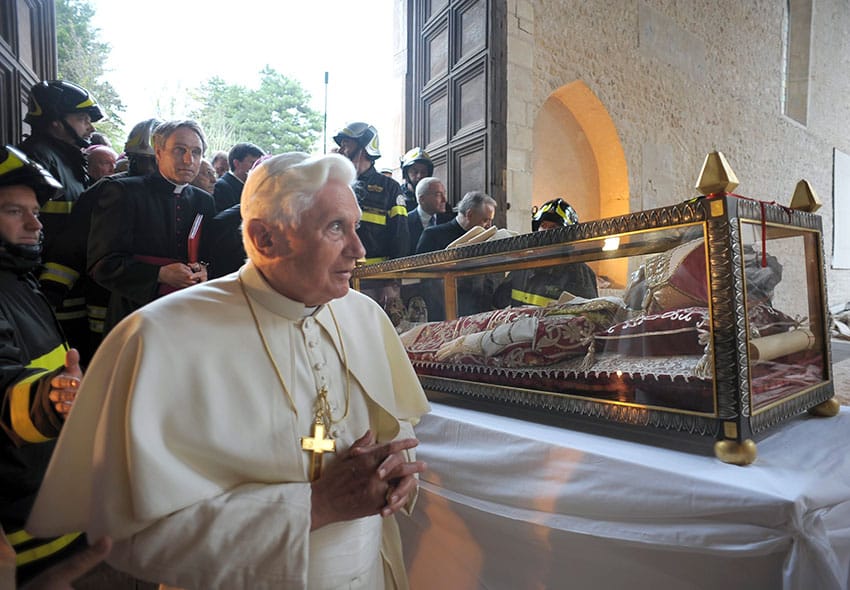
A pope of reform
Grounded in his experience growing up in the Catholic culture of Bavaria, Benedict for years had expressed deep interest in and appreciation for the liturgy. In part, this took the form of criticism of liturgical innovations that he viewed as abuses.
Thus, it was no surprise when in 2007 he restored the pre-Vatican II form of the Mass, which had been virtually suppressed after the council. The new forms, introduced with little advance preparation in 1970, would remain the “ordinary” form in the Western Church, but the old form could be used by any priest who wished. Both, he emphasised, were simply different forms of the one Roman Rite of the Mass.
Similarly, as pope he continued to promote what he viewed as the correct understanding of Vatican Council II, with his fullest exposition coming in his 2005 Christmas address to the Roman Curia. Here he blamed difficulties in implementing the council on conflict between competing interpretations of the event that he called “two contrary hermeneutics.” He described them like this:
“On the one hand, there is an interpretation that I would call ‘a hermeneutic of discontinuity and rupture’; it has frequently availed itself of the sympathies of the mass media and also one trend of modern theology. On the other, there is the ‘hermeneutic of reform’, of renewal in the continuity of the one subject-Church which the Lord has given to us.”
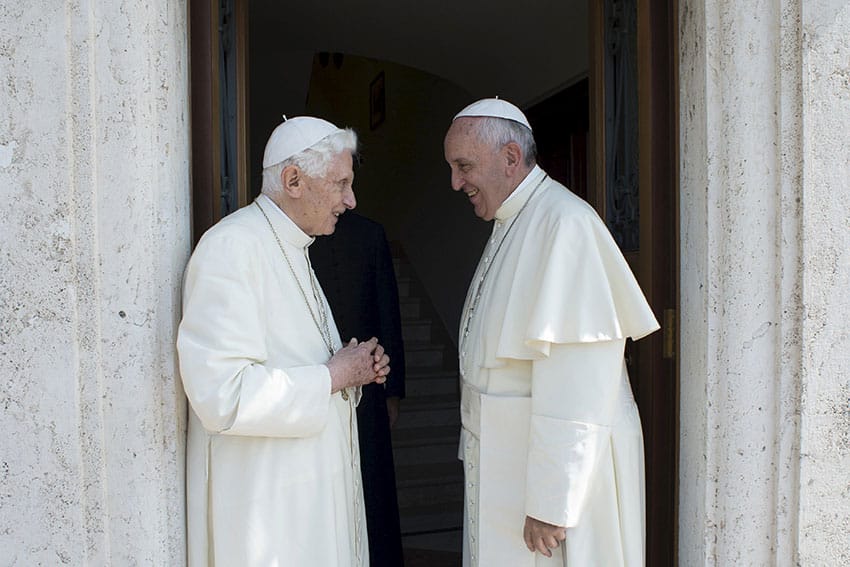
He left no doubt that the hermeneutic of reform is the right one. And he quoted Pope St. John XXIII’s address opening the council in 1962 in which John stressed the need to pass on Church doctrine “pure and integral, without any attenuation or distortion” while at the same time performing “that work which our era demands of us.” Considered this way, Benedict said, genuine reform in the Church requires “innovation in continuity … [a] combination of continuity and discontinuity.” Where this has happened, he added, “new life developed and new fruit ripened.”
To appreciate Benedict’s approach to Church renewal, Ruddy says, it’s essential to have in view its “strong Christological focus” — as in this from a book called “God and the World”: “God is no longer just in heaven … he is now also the One who is near us, who has become identified with us, who touches us and is touched by us, the One whom we can receive and who will receive us.”
If he could have his way, this reserved, devout intellectual whom events thrust into a life of high drama and no little controversy would likely be glad to have that stand as his most lasting legacy to the Church.
Russell Shaw is a contributing editor for Our Sunday Visitor. This story was reprinted with permission of Our Sunday Visitor.
Related
